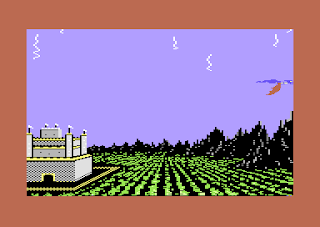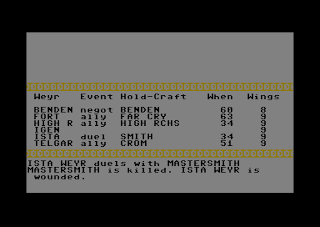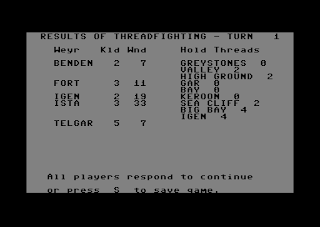As I am often wont to do, I sometimes screw around with releases not on my immediate schedule. On this day, it was checking a few PC-98 games, you know, the Japanese computer. Back when I first started emulating the system, I didn't realize the hard drive files there were designed to make your life easier, and tried installing games on my own. I failed. Shadowcaster was the first game I was interested in trying out, because, hey, its something I know. Well, now I'm back at it. I've wanted to replay Shadowcaster for the blog, but was originally going to hold off until after playing Raven Software's previous title, Black Crypt.
It did take some wrangling to get it running, but less than you'd think. I just had to use the right emulator with both a HD image and a HD boot floppy. Lo and behold, Shadowcaster...with some good music? I'm familiar enough with the game's music, but usually just the basic flourishes the game has, not the general music. It works and its actually better than I remember.
I'm not going to translate the intro text as that takes too much work and I'm not entirely certain I'd get it right. I'll try to summarize.
Kirt and his grandfather are not of our world, and they're not human, they're the People. A race of shapeshifters, who, when granted a form by a non-People race, can shift into it and vice-versa. Not all members of the People could get the ability to shapeshift, so they turned to dark gods and became heretics. A great war happened, almost wiping out the People, but the People won.
Before Kirt's grandfather is carried off, he tells Kirt to find obelisks, to seize his destiny and to find a shrine. In that order.
Two notes before I actually talk about the game. We have a video of the original game's explanation:
Now, differences between the original and the Japanese version. There is going to be a certain degree of me screwing up the translation, however, regardless of this, the dialog is different. Kirt's Grandfather places a lot of emphasis words in there and speaks quite formally. In short, his character is grand and formal. A definite difference, but one I'm not sure I care about. Also, there are indeed references to heretics/heresy here. I just felt that was amusing. I also got the impression from the text that Veste was an evil god and not the leader of the heretics. (rather than the opposite it was in the original game) I don't know if that was me, or if that was the translator.
Unlike a lot of these ports, Shadowcaster only has music over its original counterpart. Even if I did get the music running on DOS, this just sounds better. There are better CRPG ports, especially debut entries in series like Wizardry and Might and Magic, but I have a good memory of this game. This will be the fourth time I've played it over the years. I think this combination is one that works well in terms of being able to understand what I'm looking at and being able to finish the game.
 |
| I wonder how many people wandered into this game only to get slaughtered by this guy |
This thing is an enemy, and while I have to admit this part is annoying, its not the worst thing you could deal with. He has slightly longer melee range than you do, so if you don't know what you're doing, you will die. But once you get the trick, its not that hard to win. At least at this stage. He said, having won this game three times before. Even on the hardest difficulty you have enough health to win this fight. I've gone through this fight a lot more times than I have beaten this game, so I know.
Guess I should go over that difficulty setting. Difficulty in RPGs is weird, because they're the easiest genre to screw up difficulty with. Done badly, and instead of making it a challenging game, you've made it a boring game where you whack some dude for hours on end. Stats in this game don't really get high enough for that to be an issue, even on the highest difficulty. Helped by how the game gives you more experience points on higher difficulties. More points means Kirt levels up quicker, which means more health and power/mana. This is the only thing leveling up gives you, although there's slightly more to it than that. You get better at combat through a mix of player skill and items found in the game world.
 |
| "Inside yourself you hear your grandfather's voice: 'The form of the cat tribe warrior Maorin is given. Pass by the temple and the graveyard guards, the four-handed monster arrives.'" |
Touching this obelisk gives Kirt his first shape to shift to, the Maorin, a four-armed cat warrior. I'm surprised the Maorin's name managed to transfer untouched. I'm definitely going to have to check the names of some of these things later. This brings us into the real overarching RPG aspect of the game. Each form of Kirt's, including human/People form, has its own experience meter. For Kirt, this handles health and mana. For the others, this increases health. Everything you kill increases score, if you're in a non-human form, its divided between that form and Kirt's base form*. Changing into a form and staying in that form drains mana, as do most special abilities in those forces. Jumping doesn't cost anything and neither does a base attack. Succeeding in this game is all about successfully managing how stats increase in these forms.
I'll get to what's special about the Maorin in a bit, but for now, items. Around the obelisk are a fire wand and a health potion. "Fiayaa Undo" as its called here. (a phonetic spelling of fire wand) Its shoots little fireballs. The health potion heals. Items are used by placing them in a hand, either by moving them over or left clicking on an item from the inventory. Each form has its own inventory, something that's only useful at this moment.
 |
| The attack motion depends on where your hand is on the screen, lower right gives you an attack that looks like Kirt is reaching out, but I guess its a palm strike |
I'm going to be repeating a lot of this when the summary comes, aren't I? Oh, well. The first real monster you encounter are these fire plant things. As long as you're looking at them, they don't move. If you look away, they slowly sneak up on you. Hurt them enough, and they'll run away. A few run after you no matter what. The interesting bit is that they react somewhat intelligently to you, if you're very powerful they'll run away, if you're hurt they'll just rush after you. They're not very troublesome even on this difficulty. They drop flower seeds. Uh, guess that is the kanji for flower seed. These will come in handy in a little bit.
Then we have these things. These are quite possibly the nastiest enemy in the game, if only because they attack you at a weak point. They only appear on this level, but their impact is keenly felt. They're your basic enemy that shoots projectiles, but it hits pretty hard at this stage and I actually died underestimating him. More or less works like the fire plants, hurt him enough and he'll try to run away.So, basic attacks. I said that Kirt's kick was more powerful than his fist, which is true. I think it does more damage via numbers, this is a RPG, but it hits twice whereas the fist hits once. Kirt can also do a jump kick, jump then kick, which I think does a lot more damage, it certainly killed things faster. The Maorin just has its claws, and can jump, but no combo. These claws do about as much damage as the kick I think, but attack faster. However, the Maorin has slightly more health, which makes it a better choice at first. Thing is, there's no reason to use him after a few level ups with Kirt, and unless you're missing the manual, you know this because there's a rock golem later.
 |
| Kirt is such a sharp shot with a fire wand he can aim perfectly with his eyes closed |
Next on our little tour of the opening level is a floating chest next to a pillar that obviously needs some kind of item. I usually use the fire wand on this guy, but now that I think of it, there's no real reason to. This guy gives you another flower seed and the key that pillar needs. By this point even if you've been stuffing your character with these, you can't pick up any more of them. The key area isn't somewhere you want to enter yet.
At this point, you get two options for advancing, north and south. This is where things can get very dangerous if you aren't careful. And more realistically by this point, you will be in bad shape. How do you heal? You wait. Bring a book or something else you can do in-between battles. You're going to need it. This crap takes a while. A long time. Based on my experiences last time, I assumed the game would be fine so long as I was writing, but I guess that's a positive change the CD version gave. Its the game's big weakness and I don't think the game offers any way of speeding this up. At least right now, and later options then make you wait for mana to recover.
Different forms have different max healths, but I tried using the Maorin form for a while and nothing changed. It even has a lower max health now, 35 compared to the base form's 75.
So there are two things I really like about this stage. The first is how the various enemy types take advantage of their abilities against the player. There are two closed doors, each leading to a room with melee enemies. You look around, there's nothing there. You enter, and while you're attacking the melee enemies, you get sneak attacked by one of the ranged enemies. Its just out of range from when you're standing at those doors. Its a subtle thing, but it makes this stage that much more memorable.
The second bit is the game's first real puzzle, one involving the flower seeds you've been picking up. Depending on where you go, you'll find one of these flowers on top of muddy water. Attack it, and after it dies, the item you would have been able to pick up turns into a piece of ground. Walking or swimming on this water hurts you, so this is obviously the method across it. Its a simple puzzle, but it sets itself up beautifully. |
| That does not look great in screenshot form |
This gets me a giant stone head, which will come in handy later. And this more or less marks the end of the level, because I picked up another fire wand from a side area earlier, and found the exit to the next proper level. But first, a level you have to work to uncover. Remember the stone triangle and the statue? That opens a gate to another level.
He's guarding some very important treasure. A magic sword, another stone head, some Maorin armor and a mana potion. Or power potion. Armor works weird in this game, as long as you have it in a character's inventory, it should work. I've never been too sure its actually effective, but part of this is down to how I rarely use the Maorin for long enough to figure out if that's a good choice. The sword generally proves to be effective though, although the strategy guide suggests the Maorin gets more damage out of it.
This area also has these guys, imps, though they probably have a fancier name. They're not very interesting. The main section of this level are winding paths. Follow those paths and you'll eventually reach where you want to go. Don't follow those paths, and you'll probably reach there much quicker.
The first area these lead to is a pool surrounding a pillar containing many statues. Some of the statues of missing heads, four. One is here, two I already picked up, and there's another one on this level. This is where this whole section ends, because up until the point you enter there, you can return to almost any part of the previous levels. This is about as non-linear as the game gets, unfortunately.
The second is an obvious trap. A key, which when you pick up is revealed to be broken. Not before you're surrounded by spikes and a horde of the imps come out. I forgot it was imps. Its not much of a trap, because unless you really screw up your positioning, you can easily defeat these guys one at a time and they're not terribly deadly. After this its smooth sailing through another series of skeletons and the final stone head. This raises the central pillar back at the lake. Next time, the temple it leads to.
Before I end this, a few things. I picked up an acid wand and an ice wand. Interestingly, they're printed in a way that actually uses the English word as opposed to the Japanese one. The potions don't. I wonder why? Despite the music, I'm not sure this is strictly better than the DOS CD version, because I'm assuming there were changes there that this version didn't inherit outside of the bleh final levels. Regeneration in here is SLOW. I was very wrong to assume I would get through this game quickly. Because I know this game, this feels less like the usual let's plays I do and more like a guide that just so happens to be in a version I've never played before.
This Session: 1 hour 20 minutes
























































